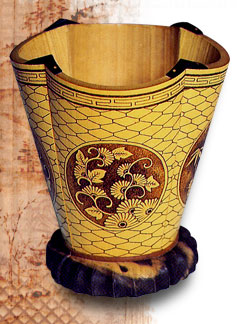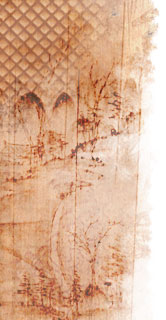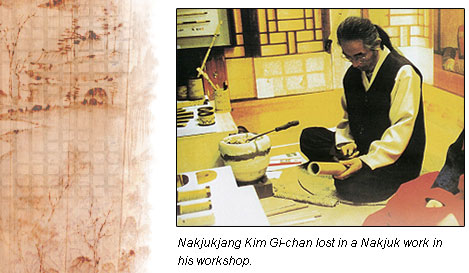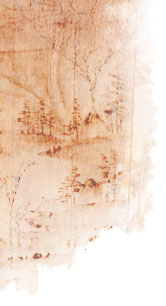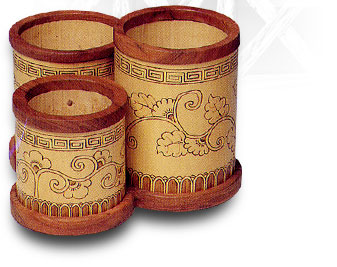A nakjuk craftsman doesn’t need to use many tools; an indu and a charcoal brazier are all he requires. An indu is a tool shaped like a hoe with an iron head that looks like a parrot’s beak whose end is sharply pointed. An artist normally uses two indus while making a piece, using them in turn. Maintaining the right temperature for the tip is the key because if the temperature is too high it can burn the bamboo surface leaving black marks behind, while if the heat is too low the finished drawing can be too dim. The temperature of an indu is measured by holding the heated end close to the cheek and feeling the heat radiating from it. A quick sense and much experience are crucial to determining the right temperature. At the same time, the artist should be equipped with the ability to make quick movements as well as strong skills because he needs to complete a character or an image before the heated tool cools down. Because a drawn image should display aesthetic beauty and meaning, a nakjuk artist must be mentally focused, creative, and highly proficient. Nakjukjang Kim Gi-chan displays incredibly exquisite expertise in depicting a landscape or a plant, and engraving words onto a tiny space. To produce a work, he needs to repeat an extremely difficult process many times to elaborately engrave thread-like fine designs onto the bamboo’s surface while maintaining an upright cross-legged position for many hours, as well as make extraordinary efforts to materialize his artistic creativity. His works are largely based on traditional designs and subjects, but each of the pieces exhibits a unique beauty expressed in Kim’s own style and ingenuity. It was through extensive research on remaining relics collected in museums that Kim succeeded in reproducing the traditional eollabit used by Korean ancestors 1000 years ago. Following his success, he started to give it creative forms and decorate it with various exquisite nakjuk designs based on the natural world, thus amalgamating function with beauty. The eollaebit made by Kim Gi-chan features a beautiful design and elegant form, and his finishing touch with camellia oil increases the natural wood texture for years to come. Kim Gi-chan’s artist name is Eulsan, which means ‘Second Tallest Mountain.’ He said that he chose the name, instead of Gapsan (‘The Tallest Mountain’), because he wants his position to be not at the very top but somewhere just below it. It is also another way of expressing his wish to live his life striving to move forward and upward, and always searching for, and challenging, what is new. “Hold a pen only with your right hand,” he said, concerning his quest for the innovative in his art, “and you get always the same writing style. But if you hold it with your left hand, you can find a new style that you never expected.” Even today, his ambitious efforts to advance forward without staying just in one place, to forge new ideas for his art as his artist name signifies, takes him on creative journeys in many different directions, opening his eyes to wonderful new experiences. |
|||||||
View the master's works |
|||||||
|













